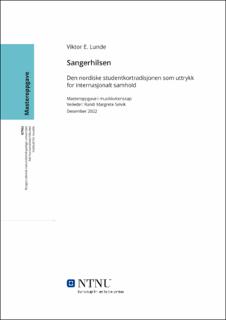| dc.contributor.advisor | Selvik, Randi Margrete | |
| dc.contributor.author | Lunde, Viktor Einarssønn | |
| dc.date.accessioned | 2023-03-07T18:19:45Z | |
| dc.date.available | 2023-03-07T18:19:45Z | |
| dc.date.issued | 2022 | |
| dc.identifier | no.ntnu:inspera:130764886:9420051 | |
| dc.identifier.uri | https://hdl.handle.net/11250/3056834 | |
| dc.description.abstract | Denne oppgaven handler om studentsangtradisjonen i de skandinaviske land og Finland, og disse
korenes forhold til den skandinavistiske bevegelsen i et historisk lys. Deretter trekkes tråder til
tradisjoner fra denne tiden som fortsatt opprettholdes i akademiske kor i Norden i dag.
Oppgaven tar utgangspunkt i spørsmålet om studentsangtradisjonen i de skandinaviske land og
Finland kan betraktes som et uttrykk for internasjonalt samhold. Jeg vil først prøve å finne ut om
det fantes en felles tradisjon blant studentkorene som oppsto i Skandinavia og Finland på 1800-
tallet ved å analysere studentkormiljøene, studentsangen og den historiske tilknytningen mellom
dem i relasjon til den politiske bevegelsen skandinavismen, som vokste fram på 1800-tallet.
Deretter vil jeg undersøke om studentkortradisjon i Skandinavia og Finland i dag fortsatt gir
uttrykk for et lignende samhold.
Metodene er litteraturstudium og kvalitativt forskningsintervju.
Litteraturstudiet gjør rede for historien til studentsangen i Skandinavia og Finland, samt
studentsangens forhold til skandinavismen, som var en bevegelse på 1800-tallet som hadde som
mål å oppnå enhet mellom de skandinaviske folk. Dette var i et århundre med store politiske
omveltninger i Europa markert spesielt av nasjonalismens framvekst. En tid da Norge gikk fra
union med Danmark til union med Sverige og fikk sin egen grunnlov, og Finland gikk fra å være
under svensk til russisk styre. Studentene i de nordiske landene lot sin stemme bli hørt. Den økte
kommunikasjonen mellom landene på 1800-tallet førte til at den svenske studentkortradisjonen
spredte seg til resten av Norden.
Et casestudium av Trondhjems Studentersangforening og intervjuene med respondenter som har
sunget i koret i nyere tid, viser at samhold på tvers av landegrensene fortsatt er en stor del av
studentsangtradisjonen. Formålet med samlingene i dag er i like stor grad forbrødring som
musikalsk utfoldelse. Respondentene kan også fortelle at dette er annerledes enn deres erfaring fra
andre lands kortradisjon. | |
| dc.description.abstract | This thesis is about Scandinavism, the academic choirs in the Nordic countries, and these choirs'
relationship to the pan-Scandinavian movement in a historical perspective. Then connections are
made to the traditions from this time that are still a part of academic choirs in Norway, and the
traces of pan-Scandinavian thinking in the traditions of the academic choirs today.
The thesis explores the question of whether the student singing tradition in the Scandinavian
countries and Finland can be considered an expression of international unity. I will first try to find
out if there was a common tradition among the student choirs that arose in Scandinavia and
Finland in the 19th century by analyzing the student choir environments, the student song, and the
historical connection between them in relation to the political movement Scandinavism, which
emerged in the 19th -the number. Next, I will investigate the student choir tradition in Scandinavia
and Finland today, and if it can be seen as an expression of a similar unity.
The methods are literature study and qualitative research interviews.
The literature study explains the history of the student song tradition in Scandinavia and Finland,
as well as the student song's relationship to Scandinavism, which was a movement in the 19th
century that aimed to achieve unity between the Scandinavian peoples. This was in a century of
great political upheaval in Europe marked especially by the rise of nationalism. A time when
Norway went from union with Denmark to union with Sweden and got its own constitution, and
Finland went from Swedish to Russian rulership. The students in the Nordic countries let their
voices be heard. The increased communication between the countries in the 19th century led to the
Swedish student choir tradition spreading to the rest of the Nordic countries.
A case study of Trondhjems Studentersangforening and the interviews with informants who have
sung in the choir in recent times, show that unity across national borders is still a large part of the
student singing tradition. The purpose of the student singing gatherings today is as much
fraternization as musical expression. The informants can also say that this differs from their
experience from other countries' choral traditions. | |
| dc.language | nob | |
| dc.publisher | NTNU | |
| dc.title | Sangerhilsen: Den nordiske studentkortradisjonen som uttrykk
for internasjonalt samhold | |
| dc.type | Master thesis | |
